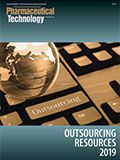Best Practices for Selecting a Service Provider
Key considerations when searching for an analytical service provider include workflow, hardware, and regulatory support.
HODA BOGDAN - STOCK.ADOBE.COM

The right service provider can be crucial to maintaining and expanding a laboratory’s workflows. Finding the best instrument for the lab’s needs, along with the right service plan, can be a time-consuming process. Investing this time at the point of purchase can result in a world of difference in a laboratory’s capabilities for years to come.
For each individual lab, there are a number of key considerations to think through to make sure the service provider and their instruments provide value and maximize lab operation, output, and return on investment. The greatest value is through quality and reliable support that will maintain or improve workflow productivity year after year.
Uptime vs. costs
Laboratory equipment and routine servicing can be expensive, particularly with mass spectrometry (MS) or liquid chromatography (LC)–MS when compared to other instruments in the lab. When making this level of investment, it is important to look beyond the cost and consider the value or impact the instrument or service may provide.
The choice between uptime and cost is a strong determining factor when making a purchase. Uptime deals with the duration the instrument needs to be in use, as well as the duration that one can afford to lose to disruption, and cost is the money one is willing to spend to avoid the disruption. Depending on the specific needs of the laboratory, some may weigh uptime over cost or vice versa.
In high-throughput analytical labs where thousands of samples can be processed daily, losing a single day to malfunctioning equipment is a major setback. In these cases, uptime is prioritized over cost, and a higher premium service plan that offers prioritized support is needed. On the other hand, in some academic labs where not as many samples are routinely processed, the impact of downtime may be less severe. This situation, combined with budgets that may be smaller, results in cost becoming a greater priority and a lower-level service plan may be more appropriate.
Determining the right balance of uptime and cost is a challenge and can sometimes turn out to be an empirical process. Though some laboratories may opt to go with third-party suppliers for their service plan, these laboratories often revert back to the original manufacturer following or even during an incident where in-depth knowledge of the instrument is required. When deciding on the service provider and plan, it is best to talk with dedicated experts who thoroughly know the instruments and are able to clearly explain the benefits and downfalls of each service plan to determine which one best meets the current and future needs of the laboratory users.
Workflow support
Traditionally, when thinking through service plans, laboratories only think about when an instrument breaks and how it will be fixed. However, it is equally, if not more, important to think about daily and long-term workflow support.
In the field of MS, research takes multiple years, with a high likelihood that the scope of work changes or expands. Some laboratories may simply need to substantially increase their throughput and workflow accordingly, while others will require more analytical capabilities. Alternatively, the focus of a laboratory may shift from analyzing one type of sample to another type, potentially requiring a radically different application of their instruments. These are only a few examples of how laboratory and customer needs can evolve. Rarely is the same application used day after day, year after year, and finding a service provider that will evolve alongside the laboratory and continue to meet its users’ needs is vital.
A service provider must be proactive in offering workflow support, and can do so by monitoring instruments in real-time. Providers are starting to offer remote support and tracking instruments in which operational health is continuously monitored while maintaining the privacy of the operator’s data as it is not tracked. This allows the service provider to anticipate and possibly prevent any downtime by monitoring and responding quickly to alarms triggered by fault conditions. Should the selected service plan (where cost is prioritized over uptime) not include the need to raise such a pre-emptive alarm, the monitoring of the instrument can still be useful for ensuring that support staff are alerted automatically to be ready to help resolve the issue.
Constant monitoring of the instruments also allows the laboratory to track their utilization. The laboratory or instrument manager can easily see if the activity levels are within the desired range or if there are any peaks and valleys that could be better balanced to optimize uptime.
The key benefit of continuous monitoring is the peace of mind for scientists in knowing their instruments are functioning properly, and that if an issue arises or is imminent, he/she will be alerted immediately, so that necessary action is taken to resolve or avoid the issue. This facilitates the effective maintenance of a steady and reliable workflow.
Hardware support
An important piece of proactive workflow support is related to parts. Typically, instrument malfunctions are related to hardware when a part or accessory is not working properly. It is important to have a reliable source that will provide new, authentic parts with long-term quality and functionality.
In researching sources for replacement parts or upgrades, there are two options: to go with the original equipment manufacturer (OEM) or a third-party. Similar to service plans, both sources have benefits and disadvantages. OEM parts are new, latest revision and come with a functional guarantee. Though they are more expensive, the OEM usually offers the greatest reliability, quality, and traceability-ensuring minimal disruption over a longer period of time. Third-party sources are more cost-effective, but do not come with the same assurances as an OEM.
The quality and cost of parts work hand-in-hand. It is important to retain additional budget, if it is not already part of a service plan, to maintain or replace parts as soon as possible to minimize any additional damage resulting from malfunctioning parts. This will be particularly valuable for older instruments, which may be more prone to malfunction. As an OEM, SCIEX continues to produce parts even if the original instrument is no longer available to ensure the full lifecycle of the instrument is covered.
Investing in hardware-in terms of replacement parts as well as the original instrument-obtained from a trusted service provider is vital to maintaining a productive and fully functional workflow long-term.
Regulatory support
A disruption in instrument performance can be a major setback and potentially detrimental, particularly in pharmaceutical laboratories. Often these labs need to operate in a controlled environment where the instruments (hardware and software) and processes need to be compliant with numerous regulations.
Confirming and maintaining compliance can be a complex, costly, and time-consuming process. Working with a service provider who is knowledgeable about global and local standards and regulatory requirements can help laboratories be well prepared for future audits.
Service providers that have a global footprint offer laboratory access to trained certified engineers from around the world. They are experts in global regulations (e.g., good laboratory practice, good clinical practice, and good manufacturing practice) and country-specific regulations, such as US FDA and China’s Food and Drug Administration, and will guide laboratories through the installation, operation, performance, re-qualification, and validation processes needed to help ensure the lab is fully compliant.
An audit is also not an area in which laboratories can afford to fail. By working with a reliable service provider with compliance expertise, laboratories will have help ensuring that they will meet all regulatory standards.
Internal maintenance
In addition to receiving support from the service provider, it is important to train laboratory staff to help with everyday instrument maintenance, troubleshoot issues, and problem-solve. This is a key factor in both independently maintaining the lab’s workflow and properly communicating with the service provider.
The focus of the laboratory will help determine the complexity of instruments and, in turn, the level of training the scientists will need. Particularly for LC–MS laboratories, where the instruments are sophisticated, intricate, and expensive, a reliably trained team can be crucial to the functionality and success of the lab.
It is beneficial to have basic-level training with each instrument purchase after the instrument is installed that focuses on basic usability and maintenance. To have more detailed training and to tailor the user and instrument to meet the exact needs of a lab, an application scientist who knows the ins and outs of the equipment as well as the particularities of the type of lab will be needed. The level of training required depends on the needs of the lab and complexity of the instrument. For instance, pharmaceutical laboratories that routinely conduct drug or pesticide screenings are likely to need more detailed training to ensure they’re meeting the required applications and standards.
Experience has shown, a team that receives regular trainings by the service provider will have an improved and consistent understanding of the instrument, and in turn, yield greater productivity and efficient troubleshooting. In fact, the majority of issues may be resolved over phone or email.
Manufacturer laboratory collaboration
Regardless of whether it is troubleshooting a problem or evolving alongside the laboratory and its uses, the service provider should work with the laboratory as a collaborative partner. Having both parties on the same page will yield greater efficiencies and advancements over time. By partnering in this way with the OEM, laboratories and their users can voice their opinions and inform the direction of new developments and innovation to best serve their current and future needs and preferences.
Greater success is often reported when a dedicated application specialist is assigned to a laboratory. This provides customers with a direct line of communication utilized solely to meet their needs, as well as provides a collaborative partner to better evolve the instruments for future applications.
Through collaborative problem-solving, more solutions are found to aid the growth and development of instruments, hardware, and software. Community formulated frequently-asked question platforms that highlight real feedback, questions, and fixes build a knowledge base for fellow laboratory users to access as well as the service provider to refer to in making improvements.
The greater the collaboration by all party experts-service provider and laboratory users-the greater the speed in finding solutions to problems and in evolving the instrument to better fit laboratory needs.
In the end, these key considerations all come down to finding a service provider that offers seamless workflow support. Laboratories need to look past the immediate support needs, such as ‘break-and-fix,’ and consider their long-term goals and the level of support needed to achieve them.
From instrument to software and compliance, steady support results in continuous work, minimal disruptions, and a greater confidence in the reliable function of the instruments. Combined, the laboratory will receive greater value from their service provider and so, yield greater success.
Article Details
Pharmaceutical Technology
Supplement: Outsourcing Resources
August 2019
Pages: s24–s27
Citation
When referring to this article, please cite it as J. Chen, “Best Practices for Selecting a Service Provider," Pharmaceutical Technology Outsourcing Resources Supplement (August 2019).

Drug Solutions Podcast: Applying Appropriate Analytics to Drug Development
March 26th 2024In this episode of the Drug Solutions Podcast, Jan Bekker, Vice President of Business Development, Commercial and Technical Operations at BioCina, discusses the latest analytical tools and their applications in the drug development market.